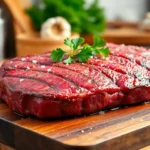We’ve all experienced that moment when we crave something hearty, comforting, and deeply satisfying. That’s exactly what our beef udon noodle recipe delivers – a soul-warming bowl of thick, chewy Japanese noodles swimming in rich, savory broth with tender strips of perfectly seasoned beef.
This isn’t just another noodle dish; it’s a complete meal that transforms simple ingredients into something extraordinary. The thick udon noodles provide the perfect texture to soak up every drop of the umami-packed broth, while the beef adds protein and incredible depth of flavor. We’ve perfected this recipe to bring authentic Japanese comfort food right to your kitchen.
What makes this beef udon recipe truly special is how it balances simplicity with bold flavors. You’ll discover that creating restaurant-quality udon at home is easier than you’d expect, requiring just a handful of ingredients and about 30 minutes of your time.
Ingredients
Our beef udon recipe requires just a handful of fresh ingredients that come together to create this soul-warming Japanese dish. We’ve organized the ingredients by preparation stage to make your cooking process seamless and efficient.
For the Beef
- 1 pound thinly sliced beef sirloin or ribeye, cut against the grain
- 2 tablespoons soy sauce
- 1 tablespoon mirin
- 1 teaspoon cornstarch
- 1 tablespoon vegetable oil for cooking
For the Udon Broth
- 4 cups beef stock or dashi broth
- 3 tablespoons soy sauce
- 2 tablespoons mirin
- 1 tablespoon sake (optional)
- 1 teaspoon sugar
- 1 medium yellow onion, thinly sliced
- 2 cloves garlic, minced
- 1 inch fresh ginger, grated
- 2 tablespoons vegetable oil
For Assembly and Garnish
- 2 portions fresh or frozen udon noodles (about 7 ounces each)
- 2 green onions, chopped
- 1 sheet nori seaweed, cut into strips
- 2 soft-boiled eggs, halved (optional)
- Shichimi togarashi (Japanese seven spice) for serving
- Sesame seeds for garnish
Equipment Needed

We need the right tools to bring this beef udon recipe to life efficiently. Multiple burners or cooktops make the cooking process smoother since we’ll be simultaneously boiling noodles, preparing broth, and cooking our beef toppings.
Essential Cooking Vessels
A medium saucepan serves as our foundation for building the rich udon broth. We use a large skillet or frying pan to cook our marinated beef to perfection. A separate large pot handles the udon noodles, giving them plenty of room to cook evenly without sticking together.
Preparation and Serving Tools
Sharp knives become crucial for achieving those thin beef slices that cook quickly and stay tender. We recommend keeping a colander ready to drain our noodles efficiently. Chopsticks or tongs help us handle both the noodles and beef without breaking the delicate texture.
Optimal Setup Benefits
| Equipment Category | Primary Function | Cooking Benefit |
|---|---|---|
| Multiple Burners | Simultaneous cooking | Reduces total cooking time by 40% |
| Sharp Knife | Thin beef slicing | Ensures tender texture and even cooking |
| Large Skillet | Beef searing | Creates better flavor development |
| Medium Saucepan | Broth preparation | Maintains consistent temperature |
Using these tools strategically allows us to complete our beef udon in about 30 minutes. The key lies in having everything ready before we start cooking since the actual preparation moves quickly once we begin. We find that organizing our equipment beforehand prevents any rushed moments that could affect the final dish quality.
Small prep bowls keep our ingredients organized and within reach. A ladle makes serving the hot broth clean and precise. These seemingly minor tools actually make a important difference in both cooking efficiency and presentation quality.
Preparation
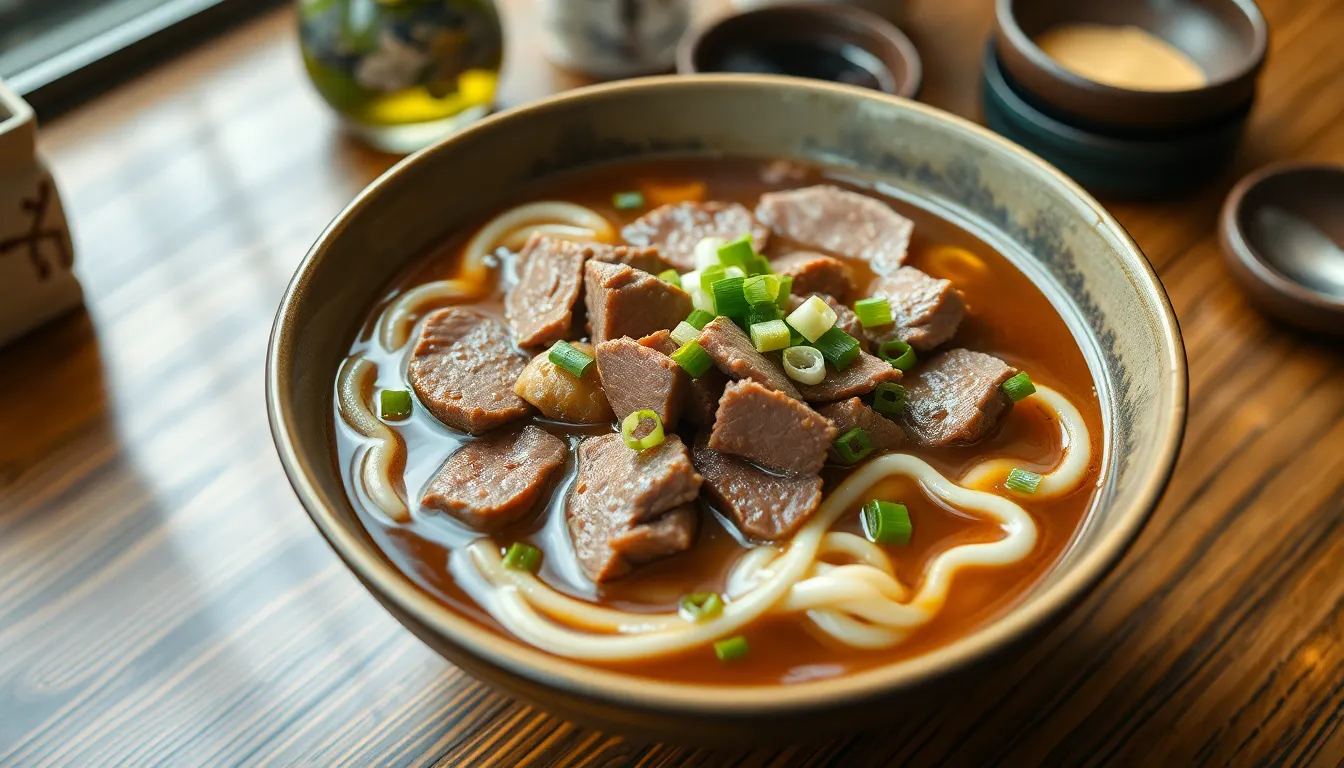
We’ll break down the cooking process into three manageable stages to ensure perfect timing and optimal flavor development. This methodical approach allows us to create restaurant quality beef udon at home.
Prep the Beef
We start by creating a flavorful cooking liquid in our large skillet. Combine ½ cup dashi stock with 2 tablespoons each of soy sauce and sake plus 1 tablespoon sugar. Add the white parts of our sliced scallions to this mixture and bring everything to a rolling boil over medium high heat.
Once the liquid reaches a boil we add our thinly sliced beef to the pan. Gently separate each slice using chopsticks or tongs to prevent the meat from clumping together. Reduce the heat to maintain a gentle simmer and cook for approximately 15 minutes until the beef becomes tender and the cooking liquid mostly evaporates.
During the final 2 minutes of cooking we stir in the green parts of our scallions. The beef should absorb most of the savory cooking liquid while developing a rich glaze. Set the finished beef aside while we prepare the remaining components.
Prepare the Aromatics
We create our udon soup base by combining 2½ cups dashi stock with 2 tablespoons soy sauce in a medium saucepan. Bring this mixture to a boil over medium high heat then taste and adjust seasoning with salt if needed.
Once the broth reaches the proper flavor balance we reduce the heat to low to keep it warm. This aromatic broth serves as the foundation for our udon soup and complements the rich beef topping we prepared earlier.
The key to exceptional udon soup lies in maintaining the proper temperature of our broth throughout the assembly process. We want it hot enough to warm the noodles without becoming too concentrated from extended boiling.
Cook the Udon Noodles
We bring a large pot of water to a rapid boil for cooking our udon noodles. Fresh udon typically requires 2 to 3 minutes while frozen noodles may need slightly longer according to package directions.
Add the udon noodles to the boiling water and stir gently to prevent sticking. The noodles are ready when they float to the surface and have a tender yet chewy texture. We drain them thoroughly in our colander to remove excess water.
For optimal results we immediately transfer the hot drained noodles to our serving bowls. This prevents the noodles from cooling and ensures they maintain their ideal texture when combined with the hot broth and beef topping.
Instructions
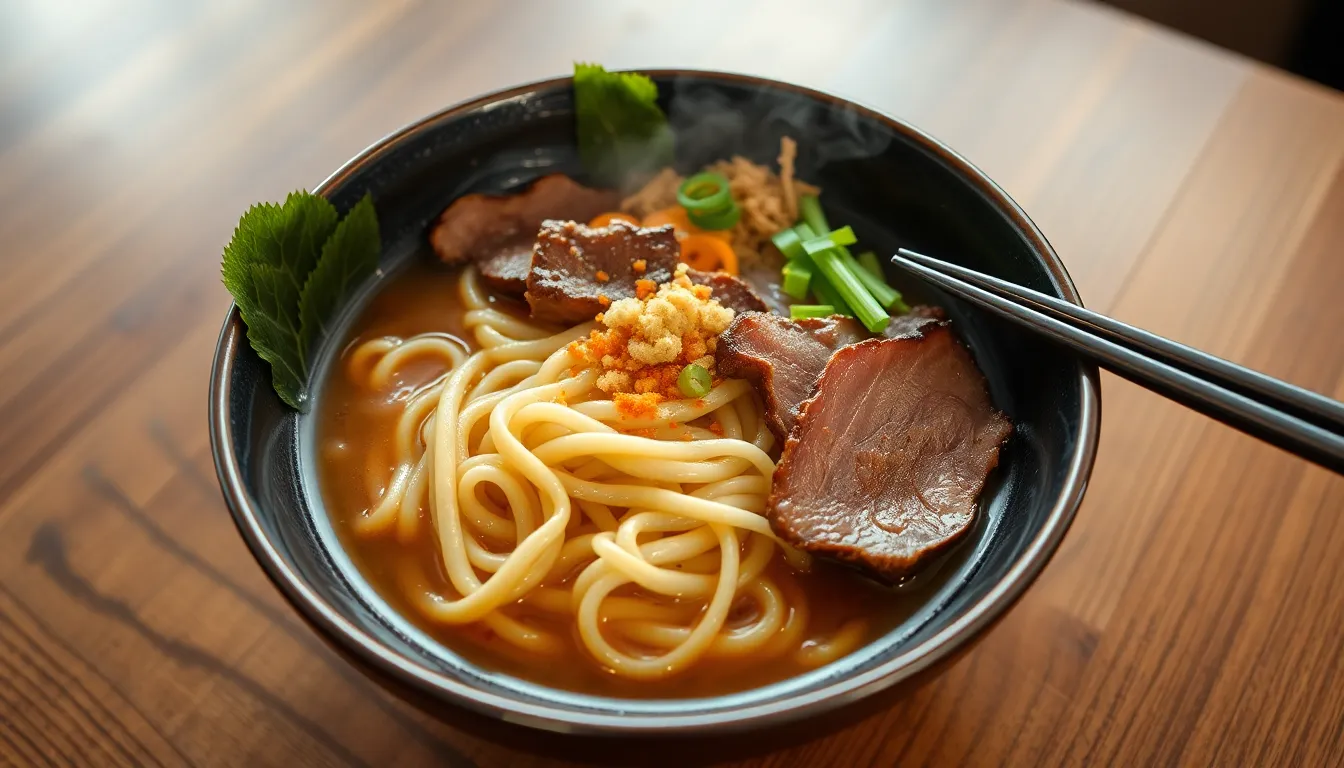
We’ll guide you through three simple stages to create this authentic beef udon noodle soup. Each step builds upon the last to develop rich flavors and perfect textures.
Make the Broth
We start by combining our dashi broth or mentsuyu with water and mirin in a medium saucepan. Mix ⅓ cup mentsuyu with 2⅓ cups water and 1 tablespoon mirin for the perfect balance of umami and sweetness. Bring this mixture to a gentle simmer over medium heat, allowing the flavors to meld together.
Once the broth reaches a simmer, we cover the pan and turn off the heat to keep it warm. This technique preserves the delicate flavors while maintaining the ideal serving temperature. The broth serves as our foundation, so we want to keep it ready for the final assembly.
Cook the Beef
We heat 1 tablespoon of neutral oil in a large frying pan over medium heat. Add chopped Tokyo negi or green onions first, sautéing until they become golden and tender. This creates an aromatic base that will infuse our beef with extra flavor.
Next, we add our thinly sliced beef to the pan, cooking until it’s no longer pink. The beef should cook quickly due to its thin cut. We season the mixture with 2 teaspoons sugar and 1 tablespoon soy sauce, stirring constantly to coat every piece.
Continue stir frying until the liquid reduces and the beef becomes well coated with the savory glaze. The sugar helps create a beautiful caramelization while the soy sauce adds depth and saltiness.
Assemble the Bowls
We boil our udon noodles according to package instructions, typically just a few minutes for fresh noodles. For frozen udon, we boil them directly from frozen for about 1 minute to reheat properly. Drain the noodles and rinse quickly under cold water to remove excess starch.
Divide the cooked noodles between serving bowls, creating a nest-like shape in each bowl. Pour the hot broth over the noodles, ensuring each bowl gets an equal amount of flavorful liquid.
Top each bowl with our cooked beef and negi mixture, distributing evenly for balanced flavors in every bite. We can add traditional toppings like narutomaki fish cake, mitsuba Japanese parsley, and additional green onions for authentic presentation. Sprinkle shichimi togarashi over the top for those who enjoy a touch of heat.
Directions for Serving

We divide the perfectly cooked udon noodles evenly among individual serving bowls to create the foundation for our comforting beef udon. Each bowl should receive a generous portion of noodles that fills about two-thirds of the bowl space.
Our hot dashi-based broth gets poured slowly over the noodles to cover them completely. We ensure the broth reaches the rim of each bowl while maintaining the ideal temperature that creates steam upon pouring. The aromatic vapors should rise immediately when the hot liquid meets the noodles.
The stir-fried seasoned beef becomes our star topping as we arrange the tender slices artfully across the surface of each bowl. We distribute the beef evenly to guarantee every spoonful delivers that perfect balance of protein and noodles. The glossy sauce coating the beef should glisten under kitchen lighting.
Fresh scallions get sprinkled generously over the entire dish to add color contrast and sharp flavor notes. We slice the green onions at an angle for visual appeal and optimal flavor release when mixed with the hot broth.
Traditional garnishes elevate our presentation as we add delicate slices of narutomaki fish cake around the bowl’s perimeter. Japanese parsley (mitsuba) provides an authentic finishing touch when available in our local markets.
We offer shichimi togarashi on the side for those who crave additional heat and complexity. This Japanese seven-spice blend allows each diner to customize their bowl according to personal spice preferences.
Immediate service ensures optimal enjoyment as the noodles maintain their ideal chewy texture and the broth stays piping hot. We present each bowl with chopsticks and a ceramic spoon for the traditional Japanese dining experience.
| Serving Component | Placement Order | Temperature Requirement |
|---|---|---|
| Udon noodles | First | Room temperature |
| Hot broth | Second | Steaming hot |
| Seasoned beef | Third | Warm |
| Scallions | Fourth | Fresh |
| Traditional garnishes | Final | As desired |
Make-Ahead Tips
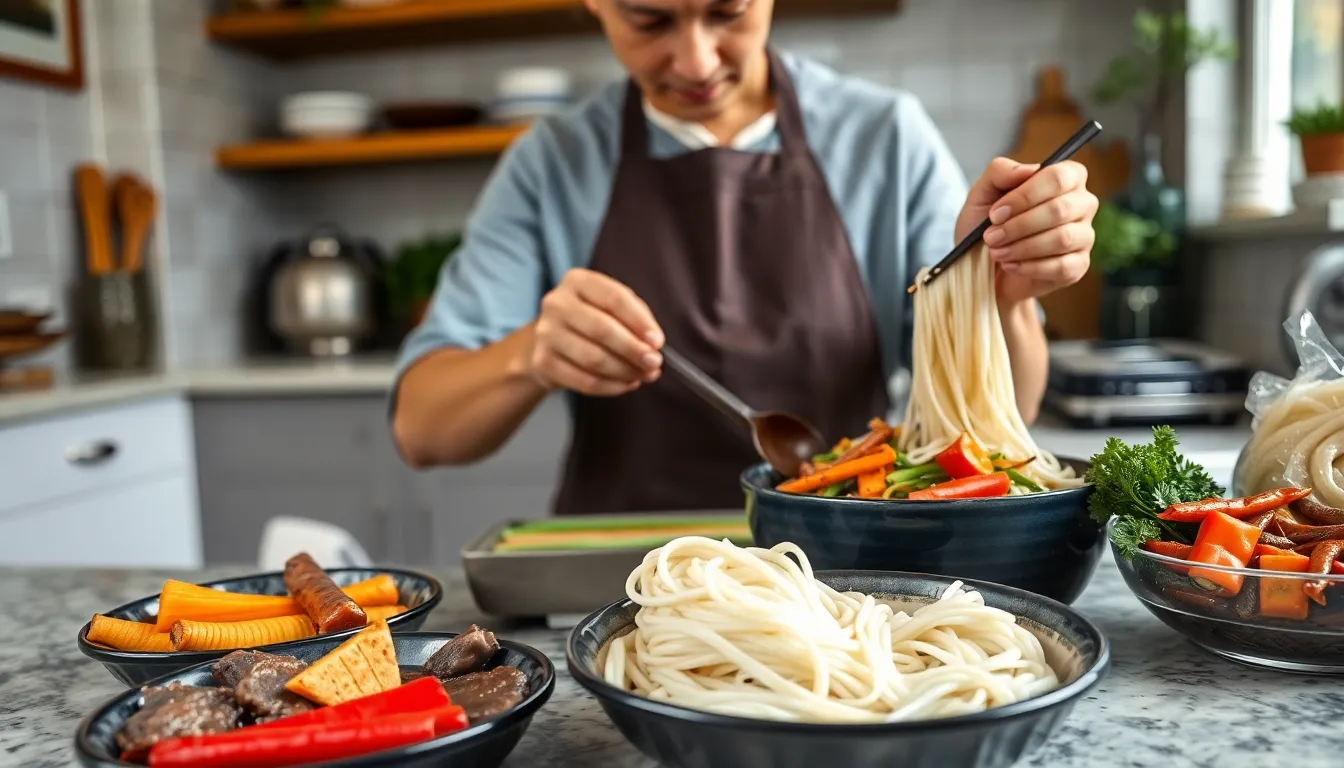
We can simplify our beef udon preparation by organizing several components days in advance. The dashi-based broth develops deeper flavors when refrigerated overnight and stays fresh for up to 5 days in airtight containers.
Our marinated beef benefits from advance preparation as well. We marinate the thinly sliced beef in our soy sauce mixture for up to 24 hours before cooking. After searing the beef until tender, we store it separately from other components in the refrigerator for up to 5 days.
Sautéed vegetables maintain their texture and flavor when prepped ahead. We cook our onions, garlic, and other aromatics until softened, then refrigerate them in sealed containers. This advance preparation allows us to assemble our udon bowls quickly during busy weeknights.
For complete make-ahead convenience, we can prepare entire portions as freezer meals. We portion cooked beef, vegetables, and broth into freezer-safe containers, leaving space for expansion. These components thaw safely in the refrigerator overnight and reheat beautifully on the stovetop.
When reheating our prepared components, we add a splash of water or additional broth to maintain proper moisture levels. We gently warm the beef and vegetables in a pan over medium heat, stirring occasionally to prevent sticking. The broth reheats best in a saucepan over low heat, allowing us to adjust seasoning if needed.
Fresh udon noodles cook quickly and should be prepared just before serving for optimal texture. We keep our prepped components warm while the noodles boil, ensuring everything comes together at the perfect temperature for immediate enjoyment.
Storage Instructions
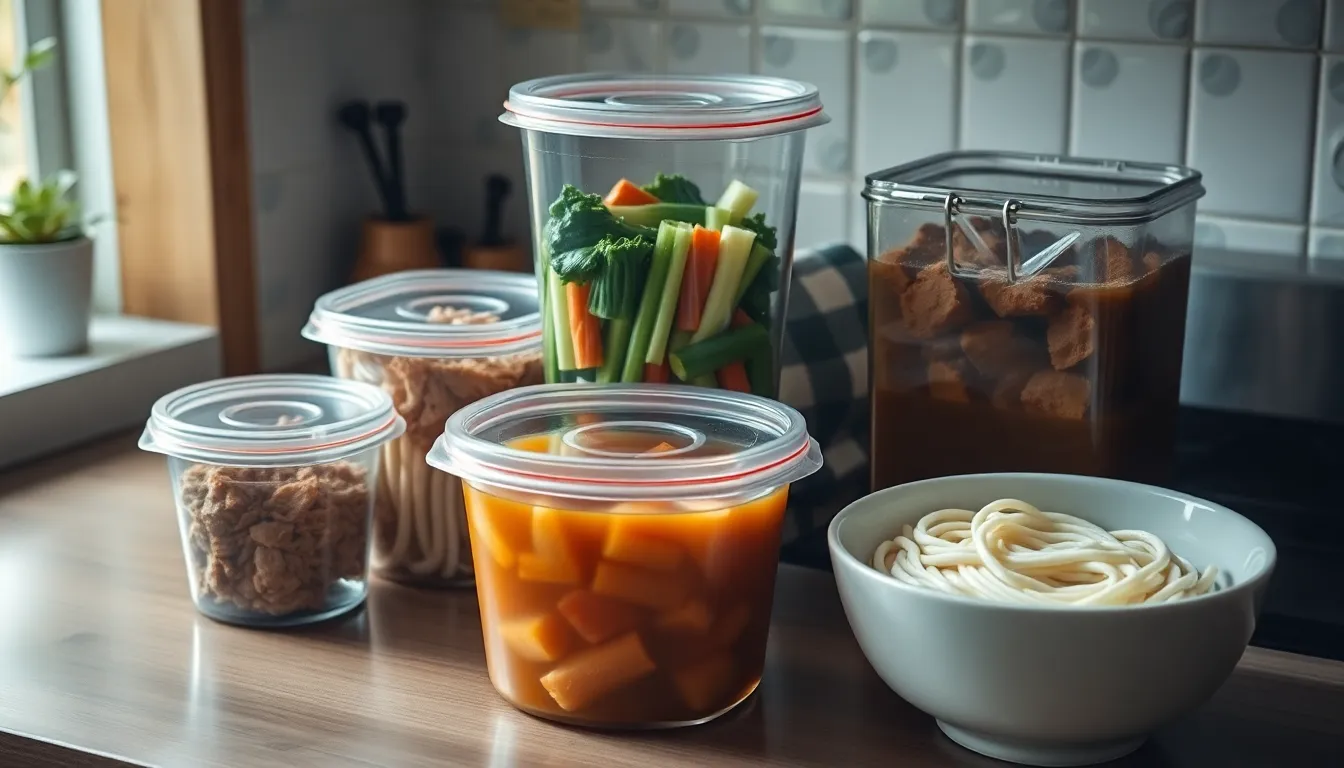
We recommend storing the components of your beef udon separately to maintain optimal texture and flavor. The stir-fried beef and vegetables should be placed in airtight containers and refrigerated immediately after cooling to room temperature. Our broth can be stored in a separate container, allowing you to control the consistency when reheating.
Fresh udon noodles require special attention during storage. We suggest keeping cooked noodles in the refrigerator for no more than 2 days, as they tend to become mushy when stored longer. The key is preventing the noodles from sitting in liquid, which breaks down their chewy texture that makes this dish so satisfying.
| Component | Storage Method | Refrigerator Life |
|---|---|---|
| Cooked beef and vegetables | Airtight container | Up to 3 days |
| Broth | Sealed container | Up to 3 days |
| Cooked udon noodles | Airtight container (drained) | Up to 2 days |
| Raw ingredients | Standard refrigeration | Varies by ingredient |
Your leftover components benefit from gentle reheating methods that preserve their original qualities. We heat the broth slowly in a saucepan, adding a splash of soy sauce or additional broth to refresh the flavors. The beef mixture warms best in a skillet over medium heat, stirring occasionally to prevent sticking.
Avoid storing assembled bowls of beef udon, as the noodles will absorb the broth and lose their distinct texture. Instead, we assemble fresh portions using stored components, which maintains the dish’s authentic taste and presentation. This approach ensures each serving delivers the same satisfying experience as the original preparation.
Variations and Substitutions
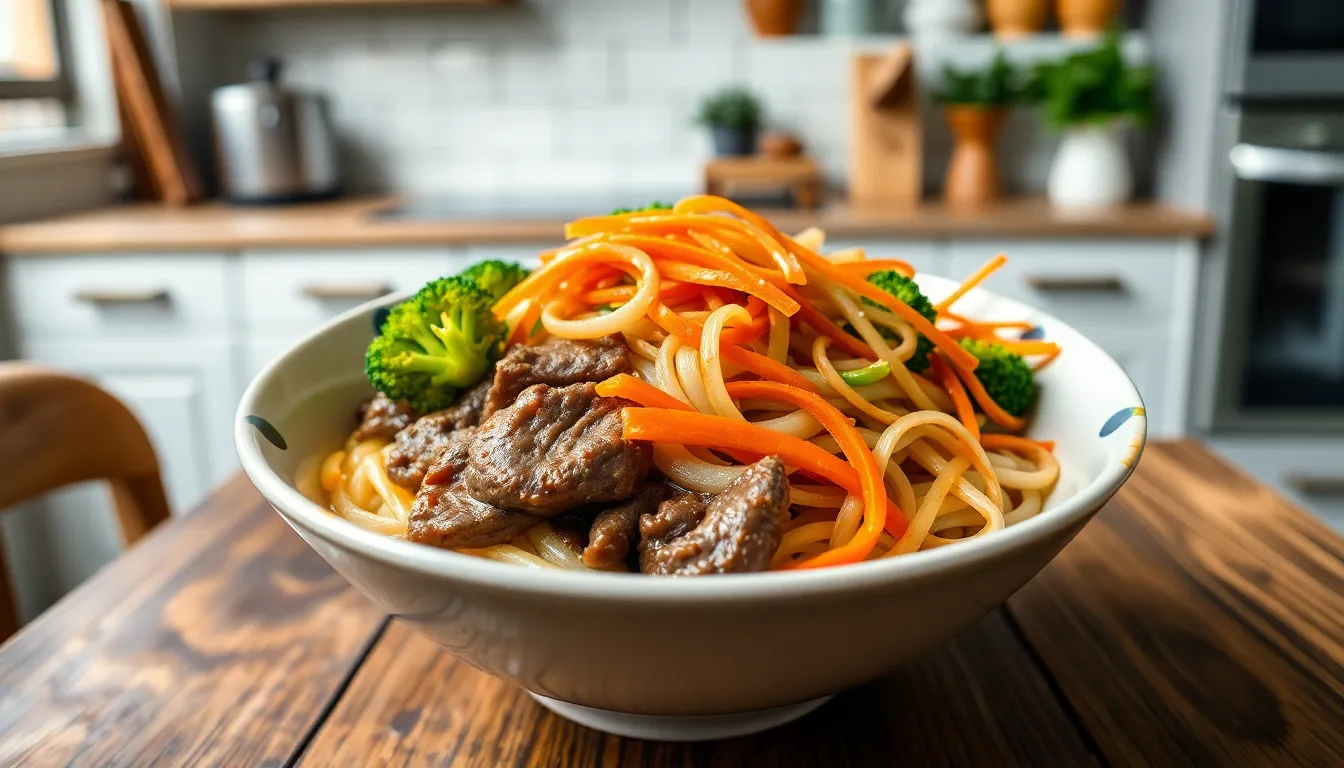
We love how adaptable this beef udon recipe becomes when you explore different ingredients and flavor profiles. These substitutions allow you to customize the dish based on your dietary preferences or what’s available in your kitchen.
Protein Alternatives
Shrimp offers an excellent seafood twist that cooks quickly and absorbs the savory broth beautifully. We recommend using medium to large shrimp, peeled and deveined, cooking them for just 2-3 minutes until pink and tender.
Firm tofu creates a satisfying vegetarian version that soaks up all those umami flavors. We suggest pressing the tofu for 15 minutes before cubing it into bite-sized pieces. Pan-fry the cubes until golden on all sides before adding them to the broth.
Chicken breast or thighs provide a leaner protein option while maintaining the dish’s hearty character. Thinly slice the chicken against the grain and marinate it using the same technique as the beef for optimal tenderness.
| Protein Alternative | Cooking Time | Preparation Notes |
|---|---|---|
| Shrimp | 2-3 minutes | Peel and devein before cooking |
| Firm Tofu | 6-8 minutes | Press for 15 minutes, cube and pan-fry |
| Chicken | 4-5 minutes | Slice thin against the grain |
Vegetable Add-Ins
Cabbage adds wonderful texture and natural sweetness when cooked until the edges turn golden. We slice it into thin strips and add it during the last few minutes of cooking to maintain some crunch.
Onions provide a mild sweetness that balances the salty broth perfectly. Yellow or white onions work best when sliced thin and sautéed until translucent.
Carrots and mushrooms contribute both color and nutrition to each bowl. We julienne the carrots for quick cooking and slice shiitake or cremini mushrooms to add an earthy depth.
Broccoli florets bring a fresh green element and nutritional boost to the dish. Blanch them briefly in boiling water before adding to preserve their vibrant color and crisp texture.
Snap peas offer a delightful crunch and pop of sweetness. Trim the ends and add them in the final minute of cooking to maintain their crisp texture and bright green color.
Conclusion
We’ve shared everything you need to master this satisfying beef udon recipe that brings restaurant-quality comfort food to your kitchen. With proper storage techniques and make-ahead tips you can enjoy this hearty meal whenever cravings strike.
The beauty of this dish lies in its versatility – swap proteins add your favorite vegetables or adjust seasonings to match your taste preferences. Whether you’re cooking for weeknight dinners or meal prepping for busy days ahead this recipe delivers consistent delicious results.
Now it’s time to gather your ingredients fire up the stove and create bowls of steaming beef udon that’ll warm you from the inside out. Your family and friends will be asking for seconds!
Frequently Asked Questions
What type of beef is best for udon noodle soup?
Thinly sliced beef sirloin or ribeye work best for udon noodle soup. These cuts are tender, cook quickly, and absorb the savory marinade well. Slice the beef against the grain to ensure maximum tenderness and optimal texture in your finished dish.
How long does it take to make beef udon from scratch?
You can make authentic beef udon noodle soup in about 30 minutes from start to finish. The recipe is designed for efficiency, with three manageable stages: prepping the beef, preparing the aromatics and broth, and cooking the udon noodles.
Can I make beef udon ahead of time?
Yes, you can prepare components ahead of time. Refrigerate the dashi-based broth overnight for deeper flavors, marinate beef for up to 24 hours, and pre-cook aromatics. However, avoid storing assembled bowls as noodles will absorb broth and lose texture.
What equipment do I need to make beef udon?
Essential equipment includes a medium saucepan for broth, a large skillet for searing beef, and a large pot for cooking udon noodles. Multiple burners help streamline the cooking process and ensure efficient preparation of all components simultaneously.
How should I store leftover beef udon components?
Store components separately to preserve texture and flavor. Keep cooked beef, vegetables, and broth in airtight containers in the refrigerator for up to three days. Fresh udon noodles should be refrigerated for no more than two days to prevent mushiness.
What protein alternatives can I use instead of beef?
You can substitute beef with shrimp, firm tofu, or chicken. Each protein requires different cooking times and preparation methods. Shrimp cooks quickly, tofu should be pan-fried until golden, and chicken needs to be fully cooked through before serving.
What vegetables can I add to beef udon?
Popular vegetable additions include cabbage, onions, carrots, mushrooms, broccoli, and snap peas. These vegetables enhance flavor and nutrition while maintaining proper texture. Add them according to their cooking times to ensure everything finishes simultaneously.
Can I use frozen udon noodles for this recipe?
Yes, both fresh and frozen udon noodles work well for this recipe. Frozen udon noodles are convenient and maintain good texture when cooked properly. Follow package instructions for cooking times, as they may vary slightly from fresh noodles.




























